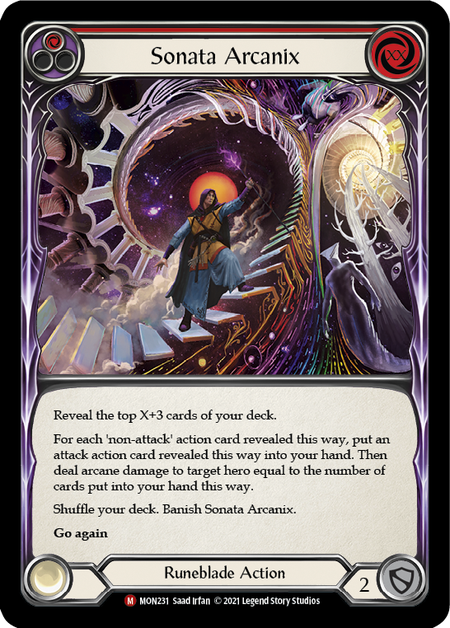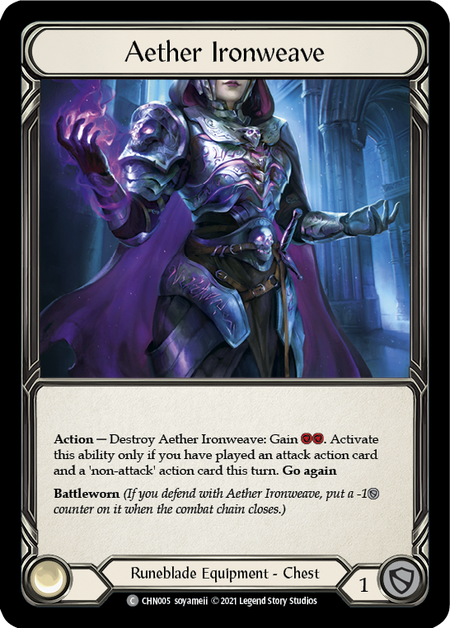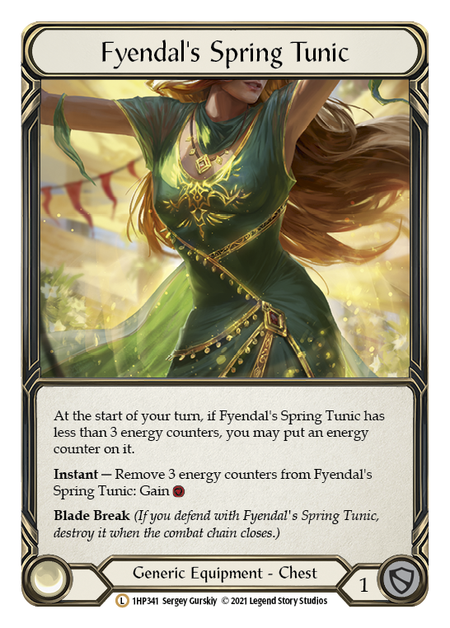After a strong showing in the recent ProQuest series, Viserai was poised to be a top contender for the upcoming Pro Tour. However, the recent suspension of Bloodsheath Skeleta – a core card for both aggressive and control-oriented Viserai playstyles – has thrown the classic Runeblade hero for a loop. Is it possible for him to make a comeback?
This is not a deck guide, but a workshop, walking through the considerations and testing ideas in an effort to save you time and collaborate. While it's too early to say for certain whether Viserai will thrive in this pocket before Uprising, let's talk about some possible paths forward.

What Was Lost?
First, a look at what was lost. Bloodsheath Skeleta was one of the most important cards for Viserai’s gameplan. Coupled with his ample ability to generate Runechant tokens, this card could create large amounts of value very easily.

Perhaps the “bread and butter” interaction with Skeleta was the Sonata Arcanix combo, where one amassed Runechants and then used them to pay for Sonata with quite a high value of X. With this method, every two Runechant tokens becomes an additional card revealed by Sonata Arcanix. With enough Runechants built up, this combination could sometimes defeat an opponent in one turn – indeed, this “OTK” (One Turn Kill) tactic was a primary strategy for Runeblade players when faced with opponents they couldn’t defeat with aggressive play.
For example, here’s my Viserai decklist from before the recent banned and suspended announcement:
This decklist had one game plan against most opponents and another against Guardians. Against “standard” opposition, the plan is to play aggressively; but against Guardians, it shifts to a defensive OTK style and tries to build up enough Runechants to win the game in one turn via Sonata Arcanix and Bloodsheath Skeleta.
This One Turn Kill (OTK) playstyle is no longer valid; without Bloodsheath Skeleta as an option, it doesn’t much seem possible to build up a big enough turn to take down an opponent in one go. While there were decks in the past that played for an OTK strategy without Sonata Arcanix – most notably by using Sloggism as the non-attack action to be discounted via Bloodsheath Skeleta – these decks were both weaker and themselves reliant on Skeleta for at least part of their combo.
Losing the OTK style is a major problem for Viserai. One of the main reasons to play him competitively was his ability to switch playstyles and be either aggressive or defensive depending on which strategy was more likely to be effective against his opponent’s hero. Without this flexibility, Viserai is in a much more difficult position.
To make matters worse, Bloodsheath Skeleta’s ability helped aggressive Viserai play as well by allowing “explosive” bursts of damage, especially when paired with Vexing Quillhand. Further, the armor it provided helped maintain aggressive play as well by making it easier to stop incoming effects from one’s opponent.
This was especially relevant in matchups such as Viserai versus Chane. I found that one of Viserai’s best hopes in this matchup was to start off aggressive, do some early damage, then build up Runechants in the midgame and try to close things out with a Sonata combination. This is no longer an option, weakening Viserai for non-OTK matchups as well.
Fresh New Clothes
With Bloodsheath Skeleta out of the picture, what’s next for Viserai? Two cards immediately present themselves as potential options: Aether Ironweave and Fyendal’s Spring Tunic.


Aether Ironweave is a card that provides one armor with Battleworn and allows a “burst” of two resources at a key moment, but requires you to have already played both an attack and a non-attack action card in the turn. This can be useful in an aggressive matchup, but suffers from the fact that its ability is not an instant, making it more difficult to use in some circumstances.
Fyendal’s Spring Tunic is worse in terms of armor than Aether Ironweave thanks to Blade Break rather than Battleworn, but can potentially provide substantially more resources over the course of an extended game. Additionally, the resource from Tunic can be taken at instant speed, which can be useful when using instants or attack reactions.

A third option might be using Heartened Cross Strap. While this card provides no armor at all, it is easier to trigger than Aether Ironweave, as you do not have to have played both an attack and non-attack action in order to get the effect.
One other note is that one could select both the Tunic and one of the other options, and choose which one to use based on the matchup – the Ironweave or Cross Strap might serve better than the Tunic in “race” matchups, while the Tunic could prove more effective in longer games.
Other Changes
That said, there are more changes to make than just the Bloodsheath Skeleta. The previous decklist I gave dedicated much of its sideboard to an OTK gameplan which is now obsolete – without Skeleta to power a huge Sonata Arcanix turn, this strategy is no longer worth going for.
What, then, replaces it? Well, the biggest Guardian threat- Bravo, Star of the Show- also suffered some setbacks with the new Restricted List. Previously, this was a difficult matchup for aggro Viserai to win thanks in large part to Awakening, so the OTK strategy tended to work better – however, maybe there’s a variation on Viserai that will allow us to push through?
The other main “problem matchup” is Chane, which tends to be an aggressive race. In the past, it was possible (though not overall favored IMO) for Viserai to win this matchup, often by racing early and then going for a big combo game to try and swing things. Now, that combo part is no longer available, putting Viserai into a more difficult position.
So how then do we respond to having to play more aggressively in these matchups?

One option that I’ve been testing involves trying to play more disruptive cards – in this case copies of Command and Conquer and Pummel. These two cards not only work well together in their own right (C&C + Pummel is a great combo) but also provide ways to potentially break up an opponent’s turn via threatening on-hit effects. Pummel also synergizes with many of the attacks that Viserai already wanted to be playing – even “just damage” cards like Amplify the Arknight, Rune Flash, or Shrill of Skullform can gain a relevant on-hit effect from Pummel, which generates even more value if it enables a Mauvrion Skies trigger!
Here’s an updated version of a Pummel-based deck that I’ve been testing with more recently:
In some ways, this deck is more aggressive than the old Viserai builds. However, it nevertheless feels like a downgrade thanks to the major loss of “explosiveness” provided from Bloodsheath Skeleta, as well as the missing versatility of that OTK gameplan. In my testing, I found that Aether Ironweave, which had seemed like the “natural” option for this build, ended up seeming a lot worse than Fyendal’s Spring Tunic – even though it seems like the more fitting aggressive option, I found Ironweave’s lack of instant speed resource generation made it much more clumsy than I’d hoped when trying to play Pummel in order to buff big attacks.
One other note was that the Chane matchup still seemed quite difficult, to my chagrin – I think this is going to be an important matchup for those trying to play Viserai competitively in upcoming events. As a result, I’ve shifted the sideboard plan for the deck to play a bunch of defense reactions in the hopes of potentially sideboarding out a bunch of my cards that block for two, running defense reactions instead, and surprising Chane opponents with a fatigue game plan! Long shot, yeah, but it just might work, and the sideboard slots seem available for it…
Why Play Viserai?
One might ask “why play Viserai at all if the Skeleta change hit it so hard?” The answer is simple: Viserai has historically had an extremely good matchup into Prism, and Prism is the only of the pre-change “top three” decks (Star of the Show, Viserai, and Prism) to not be nerfed. If players gravitate towards Prism as a result of these changes, Viserai might be just what you need – and if it’s possible to work out a version of Viserai that has good matchups into Chane as well (another hero that I expect to be out in force), it might well be a good choice for targeting the Pro Quest meta!
Other Options for Viserai Players
On the other hand, some Runeblade players might instead be thinking it’s time to swap off of Viserai. If so, the most obvious swap might be to gravitate towards Briar or Chane instead, as these are fellow Runeblade builds that use some of the same core cards (especially equipment) and at least somewhat similar playstyles. If that’s your plan, I don’t necessarily blame you! Chane is, I think, very well-positioned for the Pro Tour, while Briar is somewhat less tested at this point but looks viable – losing Autumn’s Touch hurts, but isn’t necessarily unrecoverable.
Right now, I would say that of the three Runeblades:
-Viserai was hit the hardest by the ban/suspended announcement and lost his OTK options, but still has strong aggro options and may be the best of the three against Prism.
-Briar was hit mildly by the ban/suspended announcement and can play an interesting aggressive gameplan boosted by Channel Mount Heroic, but can be somewhat reliant on drawing CMH and relevant attacks quickly in matchups against other aggressive builds.
-Chane was not nerfed at all by the ban/suspended announcement and is the fastest and most aggressive of any of the Runeblades, but is unusually vulnerable to fatigue thanks to his self-milling mechanic.
My top pick of these decks going into the Pro Tour at this point would probably be Chane, but I do think that if a Viserai build that counters Chane is available it could prove to be quite a good choice in its own right! That said, this is based on relatively limited and initial testing – it’s very possible that I’ve gotten it wrong!
Choose Your Path
Following the recent Banned and Suspended announcement, Viserai took a hard hit, going from one of the top decks in the meta to a character with a much more uncertain place in the meta. Without Bloodsheath Skeleta, the OTK plan is no longer realistically available in the way that it once was, so Viserai players have to consider how they are going to reconfigure their approaches for competitive play. It remains to be seen whether Viserai has the tools needed to compete with other aggressive builds, but if it’s possible to construct such a build it might well be a strong contender.
I should note also that this article is based on quite limited and early testing – it’s possible there’s a totally different approach that I haven’t tried and which will be much more effective! These are just some early ideas I’ve had about Viserai’s place in the environment and how he might adapt – feel free to let me know in the comments if you have found anything more promising!






